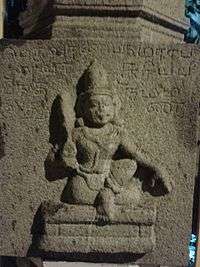List of Chola temples in Bangalore

The Chola dynasty was one of the longest-ruling dynasties in the history of southern India. In Bangalore the Cholas ruled nearly a century while the Gangas ruled from 1st to 10th century AD. The Gangas ruled over Gangawadi and the Kongu Nadu till the 10th century AD. The heartland of the Cholas was the fertile valley of the Kaveri River, but they ruled a significantly larger area at the height of their power, including the present-day Bangalore. During the reign of Rajaraja Chola I—around 1004 AD—the cholas captured Bangalore after defeating the Gangas. During their rule, they built many temples in and around the Bangalore with the Chokkanathaswamy temple, Mukthi Natheshwara Temple, Choleswara temple and the Someshwara Temple being prominent ones. The Chokkanathaswamy temple at Domlur, whose earliest inscriptions date back to the 10th century AD,[1] is the oldest temple in the city.[2] Originally built by Raja Raja Chola I,[1] the temple was later renovated by the Hoysalas and Vijayanagara rulers.[3] The temple's deity was Lord Shiva, but later a Vishnu temple was built for the local residents who were mainly Vaishnavas.[1]
The Chola Rule in Karnataka was ended in 1117 AD by the Hoysalas. However some of the Tamil workers of the Chola period continued to stay in Karnataka as a result Hoysala temples had Tamil inscriptions on them. Later Gangaraja a general of Hoysala King Vishnuvardhana ousted the tamils from South Karnataka thus ending the period of Tamil inscriptions. Hoysala Kings built Someshwara temples throughout their kingdom. The typical Someshwara temple has a lotus pond or a taverekere included.
The Someshwara temple at Madiwala was built in around 1247 AD.[4] The Someshwara Temple at Halasuru, one of the oldest in the city. While the main deity is Nandi, other gods like Brahma and Vishnu are also worshiped here.[5] Though originally built by the Hoysalas, it was later renovated by Kempegowda who built the Rajagopuram and constructed walls around the temple.[6] The 800 year-old Kaalikaamba Kamatheshwara Temple at Basavangudi is the second largest temple in the city.[7]
Apart from religious practices, the temples were utilized for scholarly activities thus providing employment for the people.[8]
List of temples
| No. | Name | Locality | Period/Earliest inscription | Refs. |
|---|---|---|---|---|
| 1 | Someshwara Swamy Temple | Agara | 1500 years | |
| 2 | Someshwara Temple | Marathahalli | 1508 AD | [9] |
| 3 | Halasuru Someshwara Temple | Halasuru | [10] | |
| 4 | Someshwara Temple | Madiwala | 1247 AD | [4] |
| 5 | Eshwara Temple | Kengeri | 1050 AD | [11] |
| 6 | Chokkanathaswamy temple | Domlur | 10th century AD | [1] |
| 7 | Mukthi Natheshwara Temple | Binnamangala | 1110 AD | |
| 8 | Kashi Vishweshwar temple | Kadugodi | ||
| 9 | Kaalikaamba Kamatheshwara Temple | Nagarathpet | 13th century AD | [12] |
| 10 | Vasantha Vallabharaya Temple | Vasanthapura | ||
| 11 | Dharmesvara Temple | Kondrahalli | 1065 AD | [13] |
| 12 | Sri Madduramma Temple | Huskur | 11th century AD | [14][15] |
| 13 | Sri Ananda Lingeshwara Temple | Hebbal |
References
- 1 2 3 4 Priyanka S Rao (19 May 2012). "Chokkanatha: The city's oldest temple". The New Indian Express. Retrieved 26 August 2014.
- ↑ U B, Githa. "A Chola temple in Domlur!". Deccan Herald. Retrieved 17 August 2014.
- ↑ Priyanka S Rao (16 May 2012). "History on the walls of a temple". The New Indian Express. Retrieved 22 August 2014.
- 1 2 "Ancient temple; bustling junction". Deccan Herald. Retrieved 26 August 2014.
- ↑ "Souvenir of the Chola dynasty". The New Indian Express. 2 January 2010. Retrieved 22 August 2014.
- ↑ S. K. Aruni (11 October 2013). "The kalyani that holds a 1,000-year history". The Hindu. Retrieved 22 August 2014.
- ↑ MK Madhusoodan. "Heritage temple in ruins; govt unmoved". DNA Syndication. Retrieved 26 August 2014.
- ↑ De 2008, p. 7.
- ↑ S.K. Aruni (11 January 2012). "Of inscriptions and the medieval period". The Hindu. Retrieved 26 August 2014.
- ↑ Dynamics of Language Maintenance Among Linguistic Minorities: A Sociolinguistic Study of the Tamil Communities in Bangalore. Central Institute of Indian Languages, 1986. p. 7.
- ↑ Patrao, Michael (2 February 2009). "A place of historical significance". DeccanHerald. Retrieved 26 August 2014.
- ↑ Madhusoodan, MK (16 January 2011). "Heritage temple in ruins; Karnataka government unmoved". Daily News and Analysis. Retrieved 27 August 2014.
- ↑ Saligrama Krishna Ramachandra Rao (1993). Art and architecture of Indian temples. Kalpatharu Research Academy. p. 222.
- ↑ Mysore & Padmanabha 1973, p. 247.
- ↑ Rao 1993, p. 214.
Bibliography
- De, Aditi (2008). Multiple city: writings on Bangalore. Penguin Books India. ISBN 978-0-14-310025-6.
- Mysore, India (Republic). Office of the Director of Census Operations,; Padmanabha, P. (1973). District Census Handbook, Series 14, Mysore: Bangalore. Govt. Press.
- Rao, Saligrama Krishna Ramachandra (1993). Art and architecture of Indian temples. Kalpatharu Research Academy.